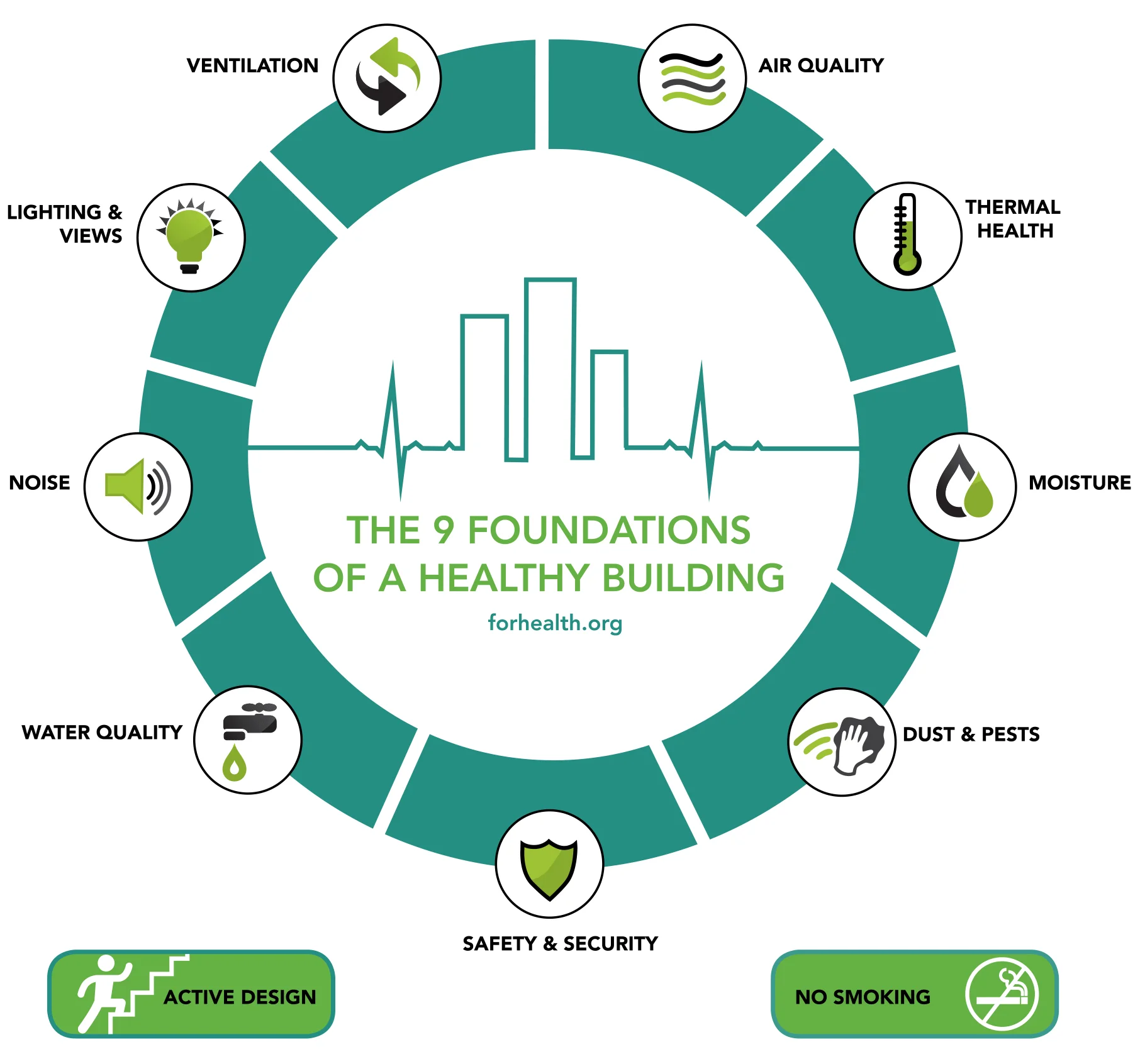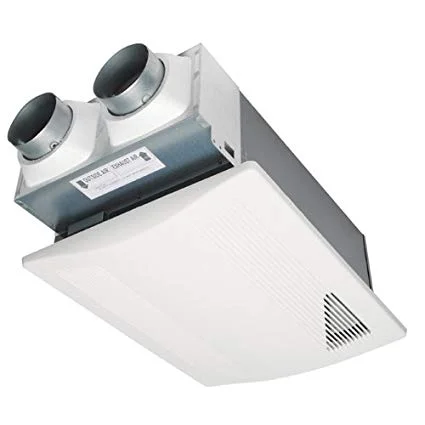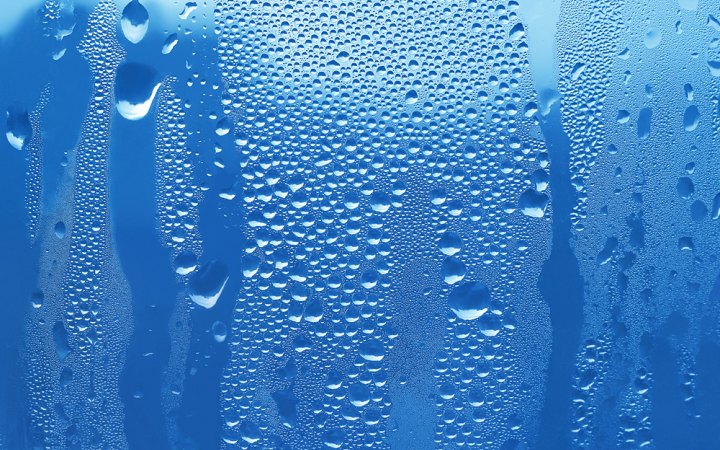Research Outcomes Of The Harvard Healthy Buildings Team
Greetings building science enthusiasts!
To reiterate a trend we see more and more, the overlap of the building sciences and health sciences continues to grow. Recently, Harvard University’s School of Public Health re-launched their Center for Climate, Health, and the Global Environment, introducing new partnerships and a new director for the institutional home of Dr. Joseph Allen’s Healthy Buildings initiative. They're calling themselves the Healthy Buildings Team and they're pretty deep into a research project on how today’s built environments impact the health, productivity, and well-being of the people inside. Their mission is simple, but ambitious: “improving the lives of all people, in all buildings, everywhere, every day.”
“Improving the lives of all people, in all buildings, everywhere, every day”
There are multiple dimensions of beauty to juggle in architecture. If you move one face, the implications can be project-wide. Start early with good principles.
This level of focus on the importance of buildings across many outcome-based measures is becoming increasingly prevalent in design and policy discussions. The bar has been raised for architects to deliver multiple dimensions of beauty and, with the emerging research on health impacts of buildings, there will absolutely be liability associated with it. But health is really just one face of the Rubik's Cube.
Recently, The Building Science Podcast got a couple of Press Passes and went to New York City for the AIA Conference on Architecture, 2018. We had the opportunity to connect with so many thoughtful and visionary architects who want to build a better, healthier future, despite the complexities.
One of the most thoughtful conversations we had was with Corey Squire and Tate Walker about the new Committee On The Environment's (COTE) new Toolkit, which directly deals with health impacts on buildings, as well as "other sides" of the Rubik's Cube. It's a resource-rich document that helps firms and projects of any kind measure their progress against benchmarks of sustainability without restrictive prescription pathways, while keeping outcomes at the central focus. Just take a look at the new COTE Toolkit's (listen to our podcast episode on the Toolkit to learn more) reasons that buildings matter:
COTE Top Ten Reasons Buildings Matter
- Integration #1 - Ranking of built environment in determining happiness
- Community 90% - % of time people spend indoors
- Ecology 45% - Buildings as % of US greenhouse gas emissions
- Water 80% - Buildings as % of municipal water supply
- Economy 87% - Buildings as % of global GDP
- Energy 75% - Buildings as % of US electricity use
- Wellness 50% - Increase in risk of adverse health effects through poor indoor air quality
- Resources 40% - Buildings as % of raw material use
- Change 400% - Return on investments in natural disaster preparedness
- Discovery 73% - Built environment % impact of on student test scores
There is a lot more that this Toolkit has to offer and we highly recommend that you take a moment to orient yourself with its contents and use them for your projects, especially if you are on the design side of the industry. It's also just the first version so any and all feedback you have for the COTE advisory board will inform and improve future versions. But just take a look at Ecology, Wellness, Integration, and Energy - all of which fit directly into the context in which we're discussing the health impacts of buildings today.
And true to the trend of overlap we mentioned earlier, we see the Harvard Healthy Buildings Team study is directly overlapping with the AIA's own design resources. Both researchers and the national organization of architects are paying attention to the impact of our professional decisions on the health of the occupants we serve. This is a big deal and we're just at the beginning. If you're young in your career, this emerging field of research will absolutely change the way you operate as a design professional going forward.
But back to the study - the Healthy Buildings team have released what we consider to be a pretty decent list that details the simple foundations of making a building healthy. Even though there's a pretty heavy commercial bias in the study, it's still applicable and sets up a really nice framework to consider these topics in broad strokes - as principles around which we can make design decisions.
The Background
The idea for the “The 9 Foundations of a Healthy Building” arose from many interactions over the past several years with real estate professionals, building owners, hospital administrators, facilities directors, homeowners, and academic colleagues. Two things stood out. First, during these discussions, we would often say, “The idea of a healthy building has been made too complicated. We know how to make buildings healthy. There are a few simple foundations.” This of course led to requests to name the foundations of a healthy building. In the ensuing discussion and debate we realized that we, the public health community, have failed to translate our research into actionable information; the richness of the public health literature was invisible to key decision-makers. Second, in these presentations and meetings we would often hearsome variation of the refrain, “Your research is very interesting, but I can’t take a scientific paper into my meeting on Monday and convince a building owner or manager to do things differently. I need a short summary.” Thus, the 9 Foundations project was born.
“The 9 Foundations of a Healthy Building” was created by a multidisciplinary team of experts from the Healthy Buildings Program at the Harvard T.H. Chan School of Public Health. You can learn more about the team and our research at www.ForHealth.org. The 9 Foundations curated summaries are designed to be a clear and actionable distillation of the core elements of healthy indoor environments. For each, we created a 2-page summary of the underlying science, fully cited back to the primary literature. These summaries are included in the following pages, along with a short guide for how to achieve each foundation. The 9 Foundations apply universally toall building types, including homes, but the supporting text focuses mainly on commercial office environments.
The 9 Foundations are the beginning of what we are calling “Building Evidence for Health” – a collection of 2-page curations of the scientific literature on key topics related to buildings and health. We began with these 9 Foundations and plan to add to this collection. As always, weare interested in improving and refining this idea, so we welcome feedback. Please write us with your ideas for topics, comments or questions. We will use your feedback and new research to update the Building Evidence for Health summaries periodically.
We hope that you find this information helpful. Our goal is to improve the lives of all people, in all buildings, everywhere, every day. We cannot do this if the knowledge generated by our research community does not reach you, the people who control, manage and occupy buildings across the world. The 9 Foundations intends to bridge this gap.
Joseph Allen, Assistant Professor of Exposure Assessment Science, Department of Environmental Health
Areas Of Focus
Obviously, all of these elements are crucial to creating a place where human beings can thrive. But there are a few of the 9 Foundations that we here at Positive Energy particularly want to bring some focus to because they are DIRECTLY affected by the work we do with architects. You're perfectly capable of checking out the rest of the list on your own, but I've digested our areas of focus below.
Ventilation
Obviously ventilation is important - yet it receives such little attention in from the codification efforts in many major cities across the world. In many ways ASHRAE has led the way in normalizing ventilation with quantitative measures, but adoption is always slow and the positive effects are subsequently slow to move into the spotlight. To see a reputable research institution like Harvard take this on is a big deal. And the study lays out a pretty reasonable approach to communicate why ventilation matters and how it can impact health.
Why Is Ventilation Important?
"Ventilation in buildings is required to bring fresh air in from outside and dilute occupant-generated pollutants (e.g., carbon dioxide) and product-generated pollutants (e.g., volatile organic compounds). If mechanically ventilated, a building’s mechanical system is designed to bring in outdoor air, filter thatair, and deliver it to occupants. Even with proper ventilation, the concentration of pollutants indoors can be higher than concentrations found outdoors. Outdoor pollutants, like PM2.5, can penetrate indoorsthrough several routes, one of which is through the mechanical system if the air stream is not properly filtered. Because people spend so much time indoors (90% or more for many people), most of a person’s exposure to outdoor air pollution may occur indoors.Ventilation systems also influence temperature, humidity, and air pressure. In an effort to ensure better Indoor Air Quality (IAQ) in building spaces, current ASHRAE standards require a minimum of 20 cubic feet per minute per building occupant (cfm/person). This standard, by definition, is designed to provide merely “acceptable” indoor air quality despite decades of research showing benefits ofhigher ventilation rates. In addition to specifying higher ventilation rates, improved maintenance of HVAC is required because substandard ventilation often occurs in buildings where HVAC systems are either neglected or inadequately maintained.
Air Quality
This is a topic that Positive Energy has seen the very clear need to address at every level possible. For us, we use research like this to inform our design details and strategies for the Integrated Mechanical Designs we do with residential architecture firms. And it's with very good reason - indoor air quality is directly affected by the enclosure and the mechanical systems we implement.
Why Is Air Quality Important?
When IAQ is poor, occupants can experience building-related illnesses such as asthma,fatigue, irritation, and headache. Because humans spend up to 90% of their time in offices, schools, andresidences, and inhalation exposure is continuous, our largest exposure to pollutants (of both indoor and outdoor origins) occurs indoors. Materials and furnishings with low chemical emissions should be used. Vapor barriers are necessary for limiting vapor intrusion and humidity levels must be stabilized to control odors.
How does poor indoor air quality affect human health?
Volatile organic compounds (VOCs) are a class of chemicals that are commonly associated with IAQ issues. VOCs are chemicals with a high vapor pressure that emit gas into the air and can come from building materials, consumer products, paints, personal care products, furniture, and many other products. Exposure to VOCs has been associated with everything from minor irritation of the eyes to certain forms of cancer. While extensive evidence has documented adverse respiratory health effects of outdoor air pollutants, more recent studies have shown that indoor air pollutants can have similar consequences. For example, the substantial presence of indoor ozone has been linked to irregular heartbeats and poor lung function as well as irritation to the eyes, skin, nose, and throat. Concentrations of pollutants indoors, in some instances have been shown to be twice as high as those outside (EPA).
Exposure to indoor air pollutants have been repeatedly linked to asthma, allergies, bronchitis, and chronic obstructive pulmonary disease. Research examining indoor pollutants in the food service sector observed a positive correlation between kitchen PM, VOCs, polycyclic aromatic hydrocarbons (airpollutants produced in the process of broiling meat and burning fuel) and kidney inflammation. Allergic reactions are also commonly associated with exposure to indoor air pollutants, among both sensitive and non-sensitive individuals.
There is so much more to say on this topic so please dive into our podcast, as well as the resources laid out in this study to begin working out how you'll tackle the challenge of designing good indoor air quality for your clients.
Thermal Health
By this point, you're probably starting to see why we like this study so much. Their categories line up so well with the critical design criteria we have been working on for the last decade. And thermal health and comfort have been a driving force in the success of bringing thoughtful and robust mechanical designs to residential projects since our nascent years as a business.
What is thermal health and why does it matter?
Traditionally, the focus in the built environmenthas been on thermal comfort, which is defined as “the condition of mind that expresses satisfaction with thethermal environment and is assessed by subjective evaluation”. Thermal comfort is influenced by objectivefactors like air temperature, mean radiant temperature, air speed, and humidity, as well as personal factors like metabolic activity level and thermal insulation from clothing.
A model developed in the 1970s by Ole Fanger, and still used today, provides a means of predicting if an occupant in a space will besatisfied in terms of thermal comfort based on these parameters. This model is the basis for the current standard that governs thermal comfort in buildings, and its stated goal is to provide an environmentwhere at least 80% of people will be satisfied. Many studies have shown that when thermal comfort parameters fall outside of theseacceptable ranges there is a significant impact on performance in offices, schools, and homes. But the impacts of thermal conditions extend beyond comfort. Temperature and humidity can also have a drastic effect on health, as evidenced by the heat wave in France in 2003, which claimed nearly 15,000 lives. In the face of rising global temperatures, these events will become more frequent. As such, we propose the use of the term “thermal health” to highlight all the health effects of thermal conditions.
There's not really much context we need to provide here. Let's continue:
How do thermal conditions impact the body?
Thermoregulation of the body is controlled by a homeostatic system that responds to external thermal cuesand internal hormonal cues to maintain core body temperature at approximately 37° Celsius. This is primarily accomplished by dilating or constricting blood vessels, which can change how fast heat dissipates from the body through convection and conduction, and by other thermoeffectors like sweating and shivering. Humidity influences the evaporative cooling mechanisms of our physiology. That is, if the humidity is too high, and theair more saturated, our body has a reduced capacity to cool itself through sweating.
The report has more great info on mechanical systems and the health impacts, which I highly recommend you read. All to say that thermal health is an extremely important and something that every project should be focused on. Of course, we're a bit biased since we're in the hot humid south and thermal conditions are important to staying sane in the summers 😉.
Moisture
We know that we have a strong bias toward talking about humidity and moisture in homes because we see the lived reality of mistakes made every day. Austin, TX is a hot and humid place and those two factors left unchecked can prove incredibly problematic for a building and result in health issues, higher energy use, an potentially even lawsuits.
Why does building moisture matter?
The scope of water damage and subsequent exposures is quite extensive; studies conducted acrossEurope, Canada, and the United States have observed mold, mildew, or water damage in up to 36% of homes.
How does moisture impact the indoor environment?
Entrance of water into damaged, poorly designed, and improperly maintained buildings has been identified as themain source of building-related illness from mold exposure in an Occupational Safety & Health Administration (OSHA)review of over 120,000 indoor air quality documents published between 1994 and 2001. Common sources of moisture in buildings can include: leaks from plumbing, roofs, and windows; flooding; condensation on cold surfaces (e.g., poorly insulated walls and windows, non-insulated cold water pipes, toilets); poorly maintained drain pans; or wet foundations from landscaping or gutters that direct water into and around a building. Secondary sources of moisture include water vapor from inadequately vented kitchens, showers, or combustion appliances. Excessive moisture collection in buildings creates favorable conditions for mold growth, which, if left unchecked, can destroy the surfaces they grow on. Moisture and mold growth can accumulate in materials such as wallboard and carpeting without being noticed even in buildings with good housekeeping and maintenance.
In buildings, molds reproduce through the accumulation of spores, tiny cells that float continuously throughindoor and outdoor air.6 When mold spores encounter a moist surface indoors, they can begin to grow on and digest their host surface. Areas typically exposed to mold in buildings are on carpets, ceiling tiles, insulation materials, wood, areas behind wallpaper, or in HVAC systems. These fungi can producea number of irritating substances, including spores and volatile organic compounds (VOCs). The latter substances are responsible for musty odor, and can contribute to adverse health effects of individuals exposed. The most common indoor molds are cladosporium, penicillium, alternaria, and aspergillus.
It's no longer just Kristof telling you this is a problem on the podcast, it's The Healthy Buildings Team at Harvard telling you this is a real problem. Be diligent in your strategies, be fastidious in your detailing, and make sure you're assembling the right project team to pull off the right level of quality.
Dust & Pests
Moreso than from the maintenance and cleaning perspective in a commercial building, we think about dust and pests from the perspective of how the building's enclosure system is preventatively working and how the mechanical system's filtration strategy is working to reduce airborne particulates. But there's some good stuff here in the study worth reading.
What is the significance of dust to human health?
Many contaminants reside in dust and lead to exposure in three different ways: 1) inhalation ofresuspended dust, 2) direct dermal absorption, or 3) ingestion from hand-to-mouth behaviors. For the first pathway, dust (also called particles) on a person’s clothes, furniture, and other upholstered materials is continuously suspended and resuspended through normal activities like walking through the house, vacuuming, or folding laundry. In fact, people have a personal “cloud” of resuspended dust around them as they go about daily activities, not unlike the famous “Pigpen” character in the Charlie Brown cartoon. When the particles are resuspended, exposure can occur through inhalation. For the second pathway, chemicals in air and dust can partition out of the air and dust onto the skin and enter our bodies via dermal absorption. The third pathway, sometimes referred to as “incidental dust ingestion,” occurs when dirt and dust accumulate on our hands and are transfered to food or are ingested directly through hand to mouth contact. It is estimated that adults ingest up to 100 mg of house dust per day and children up to 200 mg per day. Higher ingestion rates in children are due to the greater amount of time they spend in contactwith the floor and other surfaces, and higher frequency of hand to mouth behavior.
This mass of dust that enters our body every day is relevant to human health because dust acts as a reservoir or sink for a variety of potentially harmful agents – outdoor particles that penetrate indoors, viruses, bacteria, chemicals, allergens (pets, mites, mold spores, pollen),building materials, dander, fabric fibers, and paint flakes that containlead. Some of these agents (such as viruses) may only exist in dust for a few hours, while others may remain in the dust for decades. Indoor dust is the primary route of exposure for lead from lead-based paint,which can accumulate in dust from flaked paint or dirt tracked in fromoutdoors. Unlike chemicals in the air, chemicals in dust can continue to expose occupants long after the sources have been removed. This is of particular concern for Persistent Organic Pollutant (POPs), a name given to chemicals that are resistant to breakdown in the environment, and thus they can persist in the dust for many years. For example, flame retardant chemicals that are used in consumer products migrate out of those products into air and dust. Studies have documented that the amount of chemical that is present in indoor dust can be directly correlated with amount of chemical found in the blood of people living and working in those environments, providing quantitative evidence of the significant role of indoor dust in overall chemical exposure.
It's no surprise to hear this reiterated through their research. And it's absolutely all the more reason to think deeply about where dust is coming from and how to capture it. To continue the topic from a slightly different perspective, let's take a look at pests as they might be mitigated by well thought out mechanical systems.
What is the significance of pests to human health?
The primary concern from pests and domestic animals is that they introduce allergens to the indoor environment which can cause an immune response in adults and children. The most relevant sources formost indoor locations are: dust mites, cockroaches, mice, rats, cats and dogs.
Dust mites are microscopic pests that feed on shedded human and animal skin cells, typically burrowing in bedding, mattresses, and furniture upholstery. While dust mites do not bite or sting, their feces and body parts create a harmful allergen (Der p1) that can dramatically impact human health. Mites have been associated with asthma, immune responses such as allergic rhinitis (hay fever), and allergic reactions ranging from mild symptoms like runny nose and watery eyes, to more severe responses such as asthmaattacks. Among asthmatic children, the rate of dust mite allergen sensitivity can range from 48-63%, and high allergen exposure among these individuals increases their risk of hospital admission.11 In a study conducted across the United States, four out of every five homes had detectable dust mite allergens in at least one bed.
Conclusions
Again, please read the full report and get into the details of the research - especially the elements we didn't touch on here. They're deserving of exploration as well.
And now look at what's being presented here. It's no stretch to see how crucial it is that we begin thinking of buildings as vehicles of health outcomes. The decisions we make in design and construction can either support good health outcomes or cause negative health outcomes. We should not take that responsibility lightly.
When teams from top-tier research institutions, like Harvard, are pointing to the relationship between the built environment and health outcomes in our global society, it's time to stop pretending that the notion of healthy buildings is a fad that will fade out. We are at the pivot point in our industry and we are faced with the choice to either be leaders with a clean conscience or wait until the codes make us so we don't have to make the effort to figure it out before we have to.
In our minds at Positive Energy, the decision is very clear. Let your ethics be your guide.
Project Contributors
The 9 Foundations of a Healthy Building © 2017
Contributors:
JOSEPH G. ALLEN, ARI BERNSTEIN, XIADONG CAO, ERIKA SITA EITLAND, SKYE FLANIGAN, MAIA GOKHALE, JULIE M. GOODMAN, SKYLAR KLAGER, LACEY KLINGENSMITH, JOSE GUILLERMO, CEDENO LAURENT, STEVEN W. LOCKLEY, PIERS MACNAUGHTON, SEPIDEH PAKPOUR, JACK D. SPENGLER, JOSE VALLARINO, AUGUSTA WILLIAMS, ANNA YOUNG, JIE YIN
For more information:
Joseph G. Allen
Assistant Professor
Harvard T.H. Chan School of Public Health
jgallen@hsph.harvard.edu








